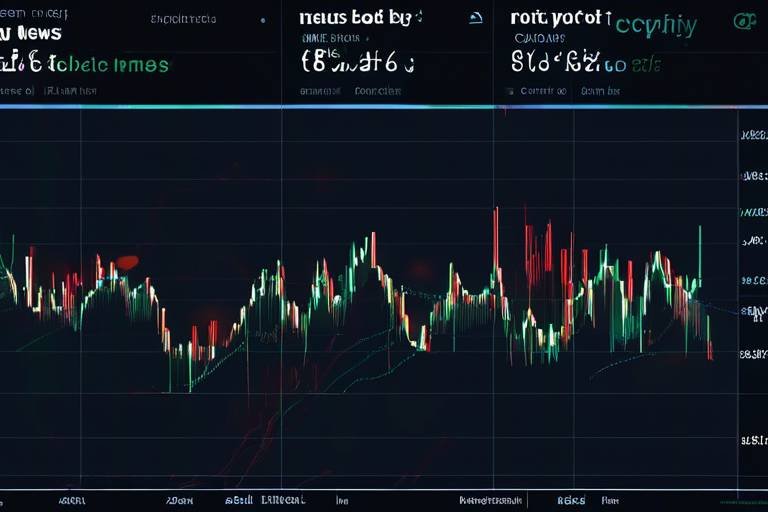Analyzing Market Trends - Short-Term vs. Long-Term Strategies
In the world of investing, understanding market trends is like having a map in a foreign land. It guides you through the often turbulent waters of financial markets, helping you navigate towards your financial goals. Whether you're a seasoned investor or just starting out, recognizing these trends is crucial for making informed decisions. Market trends can be broadly categorized into two main strategies: short-term and long-term. Each strategy comes with its unique set of benefits and risks, shaping the way investors approach their portfolios.
Short-term strategies are akin to sprinting; they focus on quick gains and often involve frequent trading. Investors who adopt this approach are usually looking to capitalize on immediate market movements, which can be both exciting and nerve-wracking. On the flip side, long-term strategies resemble a marathon. They prioritize sustained growth over time, allowing investors to benefit from compounding returns while weathering the inevitable market fluctuations. Understanding the core differences between these strategies is essential for anyone looking to optimize their investment outcomes.
This article delves deeper into the nuances of short-term and long-term market strategies, examining the advantages and risks associated with each. By analyzing various investment techniques and risk management practices, we aim to equip investors with the knowledge needed to navigate market trends effectively. So, whether you prefer the thrill of day trading or the patience of value investing, there’s a strategy that suits your style.
Market trends reflect the general direction in which a market is moving. Recognizing these trends is crucial for making informed investment decisions, whether they are short-term or long-term. Investors often rely on various indicators and tools to analyze market behavior, which can significantly impact their trading strategies.
Short-term strategies focus on quick gains, often involving frequent trading. This section will discuss the advantages and risks associated with short-term investing, including market volatility and timing.
Day trading involves buying and selling securities within the same trading day. This method requires a keen understanding of market movements and can be both lucrative and risky. Day traders must stay glued to their screens, analyzing price fluctuations and reacting swiftly to market news. The adrenaline rush can be thrilling, but it also comes with the risk of significant losses if trades don’t go as planned.
Swing trading aims to capture short-term price movements over days or weeks. This strategy balances the need for quick profits with a more manageable trading frequency. Swing traders often analyze charts and patterns to identify potential entry and exit points, making it a popular choice for those who want to avoid the intense pace of day trading while still seeking short-term gains.
Long-term strategies prioritize sustained growth over time. This section will explore the benefits of long-term investing, including compounding returns and reduced market volatility. Investors who adopt long-term strategies often find themselves less affected by short-term market fluctuations, allowing them to focus on the bigger picture.
The buy and hold strategy involves purchasing securities and holding them for an extended period. This approach allows investors to ride out market fluctuations and benefit from overall growth. By ignoring the noise of daily market movements, buy-and-hold investors can capitalize on the power of compounding, turning small investments into substantial returns over time.
Value investing focuses on identifying undervalued stocks with strong fundamentals. This strategy requires patience and thorough research to capitalize on long-term market corrections. Value investors often look for companies with solid earnings potential that the market has overlooked, waiting for the right moment to reap the rewards of their investment.
Effective risk management is essential for both short-term and long-term strategies. Investors can employ various techniques to mitigate risks and protect their portfolios. For instance, setting stop-loss orders can help limit losses on trades, while diversification can spread risk across different assets. Understanding your risk tolerance is crucial for developing a strategy that aligns with your financial goals.
Utilizing market analysis tools can enhance investment strategies. Various tools and indicators help investors make data-driven decisions in both short-term and long-term contexts. Technical analysis, for example, can provide insights into price trends, while fundamental analysis helps assess a company's financial health. By leveraging these tools, investors can make more informed choices that align with their investment strategies.
In conclusion, selecting the appropriate investment strategy depends on individual goals, risk tolerance, and market conditions. Both short-term and long-term strategies offer unique advantages and challenges. As you consider your options, remember that the best approach is one that aligns with your financial objectives and comfort level. Whether you choose to sprint or take a leisurely jog, understanding market trends will help you reach your destination more effectively.
- What is the difference between short-term and long-term investing? Short-term investing focuses on quick gains through frequent trading, while long-term investing prioritizes sustained growth over time.
- Is day trading risky? Yes, day trading can be very risky due to market volatility and the need for quick decision-making.
- What are some effective risk management techniques? Techniques include setting stop-loss orders, diversifying your portfolio, and regularly reviewing your investment strategy.
- How do I choose the right investment strategy? Consider your financial goals, risk tolerance, and the current market conditions to determine the best strategy for you.

Understanding Market Trends
Market trends are like the ever-changing currents of a river; they guide the flow of investments and dictate the landscape of financial opportunities. Understanding these trends is crucial for anyone looking to make informed investment decisions, whether you're a seasoned investor or just dipping your toes into the market waters. In essence, market trends reflect the general direction in which a market is moving, encompassing various factors such as economic indicators, investor sentiment, and global events.
Recognizing these trends can feel like trying to read the stars; it requires both knowledge and intuition. Investors who can identify whether a market is trending upwards, downwards, or sideways can position themselves to seize opportunities or protect their assets. It's not just about the numbers; it's about understanding the stories behind those numbers. For instance, a surge in technology stocks might be driven by a breakthrough in artificial intelligence, while a downturn in retail could stem from changing consumer habits.
To effectively navigate market trends, investors should familiarize themselves with different types of trends:
- Uptrends: Characterized by rising prices, uptrends signal a strong demand for securities.
- Downtrends: When prices fall consistently, downtrends indicate a lack of confidence among investors.
- Sideways Trends: In a sideways market, prices move within a narrow range, suggesting indecision among investors.
Understanding market trends isn't just about recognizing patterns; it's also about timing. Timing your entry and exit points can significantly impact your investment outcomes. For example, entering a market during an uptrend can lead to substantial gains, while investing during a downtrend can result in losses. Thus, keeping an eye on market indicators and economic reports is essential for making timely decisions.
Moreover, the influence of external factors like geopolitical events, economic policies, and even technological advancements can dramatically alter market trends. For instance, a new government policy favoring renewable energy can cause a sudden spike in related stocks, while a global crisis can lead to widespread sell-offs. Therefore, staying informed about global events and understanding their potential impact on market trends is vital for any investor.
In summary, grasping the concept of market trends is fundamental for anyone looking to navigate the complex world of investing. By understanding the forces that drive these trends and being aware of the timing and external factors at play, investors can make more informed decisions, ultimately leading to better financial outcomes.

Short-Term Strategies
Short-term strategies are all about making quick gains in the fast-paced world of investing. These strategies often require a keen sense of timing and a willingness to embrace the inherent volatility of the market. Think of it like a sprint rather than a marathon; you're looking to capitalize on rapid price movements rather than holding on for the long haul. Many investors are drawn to short-term strategies because they can yield significant returns in a relatively short period of time. However, with the potential for quick profits comes an equally significant risk, as market fluctuations can lead to rapid losses.
One of the most popular methods within short-term strategies is day trading. This approach involves buying and selling securities within the same trading day, aiming to profit from small price changes. Day traders are like hawks, constantly scanning the market for opportunities. They need to have a strong understanding of market movements and trends, as decisions must often be made in the blink of an eye. While day trading can be lucrative, it also requires a high level of skill, discipline, and the ability to manage stress effectively.
Day trading is not for the faint of heart. It demands a significant time commitment and the ability to make quick decisions. Traders often rely on technical analysis to guide their trades, using charts and indicators to predict price movements. The thrill of the chase can be exhilarating, but it's essential to remember that the stakes are high. A single miscalculation can lead to substantial losses, making risk management a critical component of this strategy.
Another short-term strategy that many investors consider is swing trading. Unlike day trading, which focuses on the same day, swing trading aims to capture price movements over several days or weeks. This method allows traders to take advantage of market fluctuations while avoiding the constant monitoring required for day trading. Swing traders often look for stocks that are poised for short-term moves based on market trends or news events. By holding onto securities for a bit longer, they can ride out minor fluctuations and aim for more significant gains.
Swing trading can be likened to fishing; you cast your line and wait for the right moment to reel in your catch. It requires patience and the ability to recognize when to enter and exit trades. Investors using this strategy often employ a mix of technical and fundamental analysis, looking for stocks that show potential for upward movement based on various indicators. While swing trading can be less stressful than day trading, it still carries risks, particularly if market conditions change unexpectedly.
In summary, short-term strategies can be an exciting way to engage with the market and potentially generate quick profits. However, they require a solid understanding of market dynamics, a willingness to accept risk, and the discipline to stick to a well-defined trading plan. Whether you're day trading or swing trading, always remember to keep an eye on the bigger picture and be prepared for the unexpected twists and turns that the market can throw your way.
- What is the primary goal of short-term trading? The main goal is to capitalize on quick price movements for immediate profits.
- Is day trading suitable for beginners? While it's possible, beginners should be cautious due to the high risks involved.
- How does swing trading differ from day trading? Swing trading involves holding positions for several days or weeks, while day trading focuses on buying and selling within the same day.
- What tools do short-term traders use? Traders often use technical analysis tools, charts, and indicators to make informed decisions.

Day Trading
Day trading is a fast-paced investment strategy that involves buying and selling financial instruments within the same trading day. Imagine it as a high-stakes game of chess, where every move counts and timing is everything. Traders aim to capitalize on small price fluctuations, often making multiple trades throughout the day to maximize their profits. However, while the potential for quick gains is enticing, the risks associated with day trading are equally significant.
One of the most appealing aspects of day trading is the ability to react swiftly to market news and trends. Traders often utilize technical analysis and charts to identify patterns and predict future price movements. This approach requires not just a keen understanding of the market but also a strong emotional discipline to avoid impulsive decisions. After all, in the world of day trading, emotions can be your worst enemy. A moment of panic can lead to a hasty sell-off, while overconfidence might result in holding onto a losing position for too long.
To succeed in day trading, it’s essential to have a well-defined strategy. Here are a few key components that can help you navigate the tumultuous waters of day trading:
- Risk Management: Establishing clear stop-loss orders is crucial. This means setting a predetermined price at which you will exit a trade to prevent excessive losses.
- Market Research: Staying updated with financial news and economic indicators can provide valuable insights into market movements.
- Trading Plan: Having a solid trading plan that outlines your goals, strategies, and criteria for entering and exiting trades can help keep you focused.
It's also worth noting that day trading is not for everyone. It requires a considerable time commitment, as traders must monitor the markets closely throughout the day. Additionally, the pressure of making quick decisions can be overwhelming, leading to stress and burnout. Therefore, before diving into day trading, it's advisable to assess your risk tolerance and ensure you have the necessary time and resources to dedicate to this strategy.
In conclusion, day trading can be a thrilling avenue for those looking to engage actively in the financial markets. However, it’s essential to approach it with caution, armed with a solid strategy and a clear understanding of the risks involved. Just like any high-stakes endeavor, the rewards can be significant, but so can the pitfalls. So, are you ready to take the plunge into the world of day trading?

Swing Trading
Swing trading is an exciting approach to investing that aims to capitalize on short-term price movements in the market. Unlike day trading, which requires buying and selling within the same day, swing trading typically involves holding positions for several days to weeks. This strategy is like catching the waves in the ocean; you want to ride the swell at just the right moment to maximize your profits. But how do you know when to jump in and when to hold back? That's where a keen understanding of market trends and technical analysis comes into play.
One of the main advantages of swing trading is its flexibility. Traders can make decisions based on both technical indicators and fundamental analysis, allowing for a more rounded strategy. For instance, you might find a stock that’s showing bullish patterns on the charts but also has strong earnings reports backing it up. This dual approach can significantly enhance your chances of success.
However, swing trading isn't without its challenges. The market can be unpredictable, and prices can swing wildly in a short period. This volatility can lead to significant profits, but it also poses risks. To manage these risks effectively, swing traders often employ various techniques, such as setting stop-loss orders to minimize potential losses. Think of it as wearing a seatbelt in a car; it’s a precaution that can save you from serious harm in case of an unexpected turn.
Another critical aspect of swing trading is timing. Successful swing traders are adept at identifying entry and exit points. They often rely on technical analysis tools, such as moving averages, Relative Strength Index (RSI), and candlestick patterns, to make informed decisions. For example, a trader might look for a stock that has recently bounced off a support level, signaling a potential upward movement. This is akin to spotting a green light in a busy intersection—it's your cue to go!
In summary, swing trading is a dynamic and engaging investment strategy that balances the desire for quick profits with a manageable trading frequency. By understanding market trends, utilizing technical analysis, and implementing effective risk management techniques, swing traders can navigate the market's ups and downs with greater confidence and success.
- What is the best time frame for swing trading? Most swing traders look at time frames ranging from 1 hour to daily charts, allowing them to capture significant price movements without the need for constant monitoring.
- How much capital do I need to start swing trading? While there is no set amount, many experts suggest starting with at least $1,000 to $2,000 to have enough capital to manage trades effectively.
- Is swing trading suitable for beginners? Yes, swing trading can be suitable for beginners, especially if they take the time to learn the basics of technical analysis and risk management.

Long-Term Strategies
When it comes to investing, are like planting a tree. You don’t just throw the seed in the ground and expect it to grow overnight; you nurture it, give it time, and with the right conditions, it flourishes. Long-term investing is all about patience and the understanding that wealth accumulation takes time. This approach prioritizes sustained growth over quick profits, allowing investors to ride out the inevitable ups and downs of the market.
One of the most appealing aspects of long-term strategies is the concept of compounding returns. Imagine your investments as a snowball rolling down a hill. As it rolls, it picks up more snow and grows larger. Similarly, with long-term investing, your returns can generate their own returns, leading to exponential growth over time. This is especially significant in the world of stocks, where the market has historically trended upward despite short-term volatility.
Another benefit of long-term investing is the reduced impact of market volatility. Short-term price fluctuations can be nerve-wracking, but if you’re in it for the long haul, these fluctuations become less of a concern. You can focus on the bigger picture and avoid the temptation to react impulsively to market news. This strategy allows investors to benefit from overall market growth and minimizes the stress that comes with daily trading.
The buy and hold strategy is a cornerstone of long-term investing. It involves purchasing securities and holding onto them for an extended period, regardless of market conditions. This strategy is akin to a long-distance race; it requires endurance and a focus on the finish line rather than the immediate hurdles. Investors who adopt this approach often find that they can weather market downturns and emerge stronger when the market rebounds.
By holding onto investments through thick and thin, investors can take advantage of the natural growth of their assets over time. It’s important to conduct thorough research before making initial purchases, ensuring that the stocks or securities chosen have strong fundamentals. This strategy not only reduces transaction costs but also minimizes the emotional strain of frequent trading.
Another popular long-term strategy is value investing, which focuses on identifying undervalued stocks that have strong fundamentals. Think of it as treasure hunting; you’re searching for hidden gems that others may have overlooked. This strategy requires patience and a keen eye for detail, as investors must conduct thorough research to determine the true value of a company. By investing in stocks that are trading for less than their intrinsic value, investors can potentially reap significant rewards when the market corrects itself.
Value investing is not for the faint-hearted, as it often involves waiting for the market to recognize the true worth of these undervalued stocks. However, for those willing to put in the time and effort, the potential for long-term gains can be substantial. Warren Buffett, one of the most successful investors of all time, is a prime example of someone who has mastered this strategy, often holding stocks for decades to realize their full potential.
In conclusion, long-term strategies offer a solid foundation for building wealth over time. By focusing on compounding returns, reducing the impact of market volatility, and employing strategies like buy and hold or value investing, investors can navigate the market with confidence. Remember, investing is a journey, not a sprint. So, take your time, do your research, and watch your investments grow!
- What is the main advantage of long-term investing? Long-term investing allows for compounding returns and reduces the impact of short-term market volatility.
- How long should I hold my investments? Ideally, long-term investors should hold their investments for several years, often a decade or more, to maximize growth potential.
- What is the buy and hold strategy? The buy and hold strategy involves purchasing securities and holding them for an extended period, regardless of market fluctuations.
- What is value investing? Value investing focuses on identifying undervalued stocks with strong fundamentals, allowing investors to capitalize on market corrections.

Buy and Hold
The strategy is one of the most popular and time-tested approaches to investing. It involves purchasing securities and holding them for an extended period, regardless of market fluctuations. This strategy is often likened to planting a tree; you nurture it over time, and eventually, it bears fruit. The essence of buy and hold is to allow investments the time they need to grow, capitalizing on the power of compound interest and the natural upward trajectory of the market.
One of the key benefits of the buy and hold strategy is its simplicity. Investors don’t need to constantly monitor the market or make quick decisions based on short-term price movements. Instead, they can focus on selecting quality investments that have solid fundamentals. For instance, companies with strong earnings growth, robust management teams, and a competitive edge in their industries tend to perform well over the long haul. By holding onto these investments, investors can ride out the inevitable ups and downs of the market.
However, it's important to note that while buy and hold can lead to substantial returns, it also requires a certain level of patience and discipline. The market can be unpredictable, and there will be times when the value of your investments dips significantly. During these periods, it can be tempting to panic and sell. But remember, selling during a downturn can lock in losses and prevent you from benefiting when the market recovers. This is where the emotional aspect of investing comes into play; having a clear strategy helps mitigate the stress of market volatility.
Moreover, the buy and hold strategy aligns well with the concept of long-term capital gains, which are typically taxed at a lower rate than short-term gains. This means that by holding onto your investments for longer periods, you may also be able to keep more of your profits when you eventually sell. Additionally, many companies offer dividends, which can provide a steady income stream while you wait for your investments to appreciate.
To illustrate the effectiveness of the buy and hold strategy, consider the following table that compares the performance of two hypothetical investors over a 10-year period:
| Investor | Investment Strategy | Initial Investment | Value After 10 Years |
|---|---|---|---|
| Investor A | Buy and Hold | $10,000 | $25,000 |
| Investor B | Frequent Trading | $10,000 | $15,000 |
As seen in the table, Investor A, who adopted the buy and hold strategy, saw their investment grow significantly over the decade, while Investor B, who engaged in frequent trading, ended up with a much lower return. This example underscores the potential benefits of sticking with a buy and hold approach, especially during volatile market periods.
In conclusion, the buy and hold strategy is not just about choosing the right stocks; it’s also about having the right mindset. It requires a belief in the long-term growth potential of the market and the companies you invest in. By embracing this strategy, you can position yourself for success, allowing your investments to grow and flourish over time.
- What is the main advantage of the buy and hold strategy? The main advantage is that it allows investors to benefit from long-term market growth and compounding returns without the stress of frequent trading.
- How long should I hold my investments? Ideally, you should hold your investments for several years, often at least five to ten years, to maximize the potential for growth.
- Is buy and hold suitable for all investors? While it can be beneficial for many, it may not be suitable for those who prefer active trading or have a low tolerance for market fluctuations.

Value Investing
is a strategy that revolves around the principle of identifying undervalued stocks in the market. Imagine walking through a bustling marketplace and spotting a diamond hidden among a pile of rocks. That's what value investors do—they search for those hidden gems that others might overlook. This approach requires a keen eye for detail and a strong understanding of a company's fundamentals, such as earnings, dividends, and overall financial health.
One of the key tenets of value investing is the concept of margin of safety. This means purchasing stocks at a price significantly lower than their intrinsic value, providing a buffer against potential losses. For instance, if a company's stock is worth $100 based on its fundamentals, a value investor might only buy it if it’s priced at $70 or less. This strategy not only minimizes risk but also positions the investor for substantial gains when the market eventually recognizes the stock's true value.
It's important to note that value investing is not a get-rich-quick scheme. It requires patience and a long-term perspective. Investors might find themselves holding onto a stock for years before it appreciates in value. During this time, market fluctuations can be nerve-wracking, but staying the course is crucial. As the famous investor Warren Buffett once said, “The stock market is designed to transfer money from the Active to the Patient.”
Moreover, value investing often involves thorough research and analysis. Investors need to delve deep into financial statements, industry trends, and economic indicators. This rigorous analysis helps them make informed decisions and identify stocks that are not only undervalued but also have strong fundamentals that can lead to future growth. Here’s a quick overview of the essential steps involved in the value investing process:
- Research: Analyze financial statements, earnings reports, and market conditions.
- Identify Undervalued Stocks: Look for stocks trading below their intrinsic value.
- Evaluate Fundamentals: Assess the company's management, competitive advantage, and market position.
- Monitor Investments: Keep an eye on market trends and adjust your portfolio as needed.
In summary, value investing is a disciplined approach that emphasizes the importance of patience, research, and a focus on long-term growth. While it may not appeal to those seeking immediate rewards, it offers a robust framework for building wealth over time. By understanding the fundamentals and maintaining a steady hand, value investors can navigate the market's ups and downs while reaping the benefits of their strategic investments.
- What is value investing?
Value investing is a strategy focused on buying undervalued stocks with strong fundamentals, aiming for long-term growth. - How do I identify undervalued stocks?
Look for stocks trading below their intrinsic value by analyzing financial statements, earnings, and market conditions. - Is value investing risky?
Like all investments, value investing carries risks. However, purchasing stocks with a margin of safety can help mitigate potential losses. - How long should I hold a value stock?
Value investing typically requires a long-term perspective, often holding stocks for several years until their true value is recognized.

Risk Management Techniques
When it comes to investing, whether you're a short-term trader or a long-term holder, understanding and implementing is crucial. After all, investing without a safety net can feel like walking a tightrope without a harness. So, how can you safeguard your investments while still aiming for those tantalizing returns? Let’s dive into some effective strategies.
First off, one of the most fundamental techniques is diversification. This means spreading your investments across various asset classes—like stocks, bonds, and real estate—to reduce exposure to any single asset's risk. Imagine you have a basket of eggs; if one cracks, you still have others intact. In investing, if one sector underperforms, the others may balance it out, protecting your overall portfolio. A well-diversified portfolio can look something like this:
| Asset Class | Percentage of Portfolio |
|---|---|
| Stocks | 50% |
| Bonds | 30% |
| Real Estate | 10% |
| Cash | 10% |
Another essential technique is setting stop-loss orders. This tool allows investors to specify a price at which their securities will be sold automatically. Think of it as a safety net that catches you before you fall too far. For example, if you buy a stock at $100 and set a stop-loss at $90, your shares will automatically sell if the price drops to that level, limiting your loss. It's like having a parachute that activates when you start to plummet!
Moreover, it’s vital to regularly review and adjust your portfolio. Market conditions change, and what worked yesterday may not work today. By regularly assessing your investments, you can make informed decisions about whether to hold, sell, or buy more of a particular asset. This practice is akin to tuning a musical instrument; you need to make adjustments to ensure everything sounds harmonious. Keeping an eye on market trends and your investment performance can help you stay in tune.
Finally, consider employing a risk-reward ratio analysis. This involves comparing the potential profit of a trade to its potential loss. A common rule of thumb is to aim for a risk-reward ratio of at least 1:3, meaning for every dollar you risk, you should aim to gain three. This helps ensure that even if you have a few losing trades, your overall performance remains positive. It’s like betting on a horse race; if you place your bets wisely, even a few losses won’t break the bank.
In conclusion, mastering risk management techniques is not just about protecting your investments but also about empowering you to make confident decisions in your trading journey. By diversifying your portfolio, using stop-loss orders, regularly reviewing your investments, and analyzing risk-reward ratios, you can create a robust strategy that withstands market fluctuations. Remember, investing is a marathon, not a sprint, so take the time to build a solid foundation for your financial future.
- What is the main purpose of risk management in investing? Risk management aims to minimize potential losses while maximizing potential gains, ensuring a balanced and sustainable investment approach.
- How often should I review my investment portfolio? It's advisable to review your portfolio at least quarterly or whenever there are significant market changes or personal financial shifts.
- What is a stop-loss order? A stop-loss order is an instruction to sell a security when it reaches a certain price, helping to limit potential losses.
- Can diversification eliminate risk completely? No, while diversification can reduce risk, it cannot eliminate it entirely. All investments carry some level of risk.

Market Analysis Tools
When it comes to navigating the complex world of investing, having the right tools at your disposal can make all the difference. are essential for both short-term and long-term strategies, acting as your compass in the ever-changing landscape of financial markets. These tools help investors make informed decisions based on data rather than emotions, which can often lead to impulsive actions. So, what are some of the most effective tools out there?
First off, let’s talk about technical analysis tools. These tools focus on price movements and trading volumes to forecast future price trends. Commonly used indicators include:
- Moving Averages: These smooth out price data to create a trend-following indicator, helping to identify the direction of the market.
- Relative Strength Index (RSI): This momentum oscillator measures the speed and change of price movements, indicating overbought or oversold conditions.
- Bollinger Bands: These consist of a middle band (a moving average) and two outer bands. The distance between the bands indicates market volatility.
Next, we have fundamental analysis tools. These tools focus on evaluating a company's intrinsic value by analyzing various economic, financial, and other qualitative and quantitative factors. Some key metrics include:
- Price-to-Earnings (P/E) Ratio: This ratio helps investors assess whether a stock is overvalued or undervalued compared to its earnings.
- Debt-to-Equity Ratio: This indicates how much debt a company is using to finance its assets relative to the value of shareholders’ equity.
- Dividend Yield: This measures how much a company pays out in dividends each year relative to its stock price, providing insight into its profitability.
Furthermore, there are sentiment analysis tools that gauge market sentiment by analyzing news articles, social media posts, and other public data. These tools can provide valuable insights into how the market feels about a particular stock or sector, which can be crucial for timing your trades.
Lastly, let’s not forget about portfolio management tools. These tools assist investors in tracking their investments, assessing performance, and rebalancing portfolios. They often come with features such as:
- Performance Tracking: Monitor how your investments are performing against benchmarks.
- Risk Assessment: Evaluate the risk level of your portfolio and adjust your strategy accordingly.
- Asset Allocation: Help in diversifying your investments to minimize risk and maximize returns.
In summary, the right market analysis tools can empower investors to make educated decisions, ultimately leading to better investment outcomes. Whether you’re day trading or adopting a buy-and-hold approach, integrating these tools into your strategy can enhance your ability to navigate market trends effectively.
Q: What are market analysis tools?
A: Market analysis tools are resources that help investors evaluate financial markets, assess potential investments, and make informed decisions based on data.
Q: How do I choose the right market analysis tools?
A: Choosing the right tools depends on your investment strategy, whether it's short-term or long-term, and your personal preferences for data analysis.
Q: Can market analysis tools guarantee investment success?
A: While they can significantly improve decision-making, no tool can guarantee success due to the inherent risks and uncertainties in the market.
Q: Are there free market analysis tools available?
A: Yes, many platforms offer free tools, although premium features often come with paid subscriptions.

Conclusion: Choosing the Right Strategy
In the ever-evolving landscape of investing, the choice between short-term and long-term strategies is not merely a matter of preference, but one that hinges on a variety of personal factors. Each approach carries its own set of advantages and challenges, and understanding these can significantly affect your investment journey. So, how do you decide which path to take?
First and foremost, consider your financial goals. Are you looking to make a quick profit, or are you in it for the long haul? Short-term strategies, such as day trading or swing trading, can be enticing with the promise of immediate returns. However, they also come with heightened risks, particularly due to market volatility. On the other hand, long-term strategies like buy and hold or value investing can offer more stability and the potential for compounding returns over time, but they require patience and a strong belief in your chosen investments.
Next, assess your risk tolerance. If you thrive on excitement and can handle the stress of rapid market fluctuations, short-term trading might suit you. Conversely, if you prefer a more laid-back approach and can withstand the ups and downs of the market over several years, long-term investing may be the way to go. Remember, it’s essential to align your strategy with your comfort level to avoid making impulsive decisions that could derail your financial goals.
Additionally, consider the current market conditions. Are we in a bull market where short-term gains are more accessible, or is the market experiencing a downturn that favors long-term strategies? Keeping an eye on economic indicators and trends can help you adapt your approach as needed. It's like steering a ship; sometimes you need to adjust your sails based on the winds of the market.
Ultimately, the best strategy is one that combines your unique goals, risk tolerance, and market awareness. Some investors even find success in a hybrid approach, utilizing both short-term and long-term strategies to diversify their portfolios and manage risk more effectively.
- What is the best investment strategy for beginners? Beginners may benefit from long-term strategies such as buy and hold, as they require less active management and can be less stressful.
- Can I switch between short-term and long-term strategies? Absolutely! Many investors adjust their strategies based on market conditions and personal circumstances.
- How do I know my risk tolerance? Assess your comfort level with losing money and your investment timeline. Consider consulting a financial advisor for a more detailed evaluation.
- What tools can help me analyze market trends? There are numerous tools available, including stock screeners, financial news websites, and technical analysis software.
Frequently Asked Questions
- What are market trends and why are they important?
Market trends indicate the general direction in which a market is moving, whether upward, downward, or sideways. Understanding these trends is crucial because they help investors make informed decisions, allowing them to capitalize on potential gains and minimize losses.
- What is the difference between short-term and long-term investing?
Short-term investing focuses on making quick gains through frequent trading, often taking advantage of market volatility. In contrast, long-term investing prioritizes sustained growth over time, allowing investors to benefit from compounding returns and ride out market fluctuations.
- What is day trading?
Day trading is a strategy where investors buy and sell securities within the same trading day. This method requires a deep understanding of market movements and can lead to significant profits, but it also comes with high risks due to the volatile nature of the market.
- How does swing trading work?
Swing trading is a strategy that aims to capture price movements over a period of days or weeks. It strikes a balance between the rapid pace of day trading and the longer timelines of traditional investing, making it a popular choice for many traders looking for quick profits without constant monitoring.
- What is the buy and hold strategy?
The buy and hold strategy involves purchasing securities and holding onto them for an extended period, regardless of market fluctuations. This approach allows investors to benefit from overall market growth and compounding returns, making it a favored strategy for long-term investors.
- What is value investing?
Value investing is a strategy that focuses on identifying undervalued stocks with strong fundamentals. It requires thorough research and patience, as the goal is to capitalize on long-term market corrections when the true value of these stocks is realized.
- How can I manage risks in my investment strategy?
Effective risk management involves various techniques, such as diversification, setting stop-loss orders, and regularly reviewing your portfolio. By employing these strategies, investors can mitigate risks and protect their investments in both short-term and long-term scenarios.
- What market analysis tools should I use?
There are several market analysis tools available, including technical indicators, charting software, and fundamental analysis resources. These tools help investors make data-driven decisions, enhancing their investment strategies in both short-term and long-term contexts.
- How do I choose the right investment strategy for me?
Selecting the appropriate investment strategy depends on your individual goals, risk tolerance, and the current market conditions. It's essential to assess your financial situation and preferences to determine whether a short-term or long-term strategy aligns with your objectives.



















